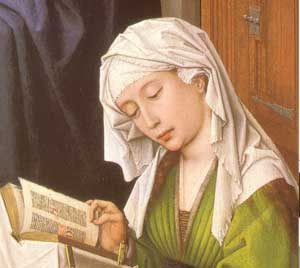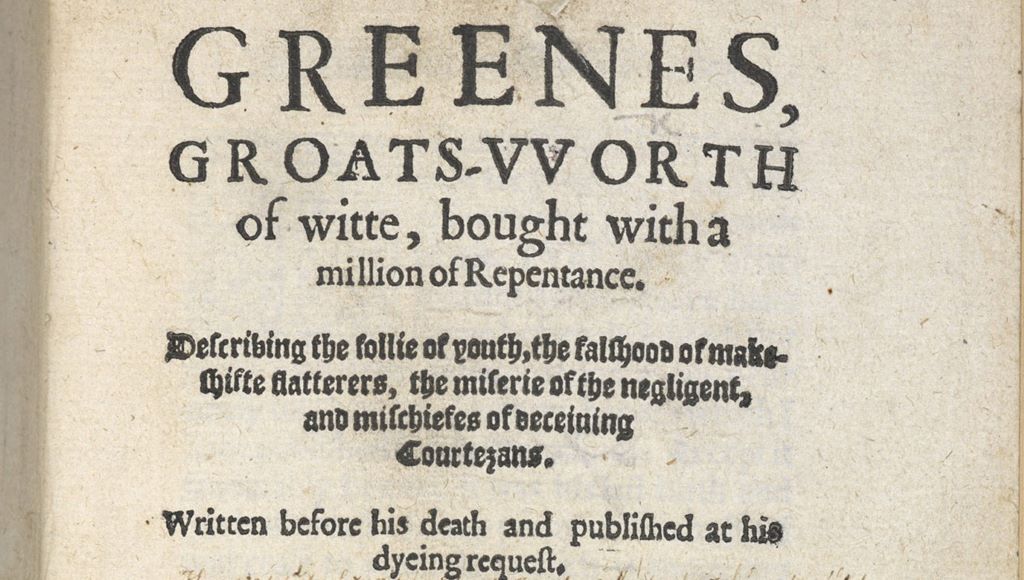The University Wits were already established playwrights when William Shakespeare arrived in London.
When William Shakespeare arrived in London sometime between 1584 and 1595, the London theatre scene was the most vibrant it had ever been. New and dynamic playing companies were being formed, purpose-built theatres were being erected for the first time, and young and exciting playwrights were taking London by storm. Shakespeare could have found no better time to arrive, and all these circumstances would come together to launch him on his own career. In fact, the young Shakespeare would become just one of many playwrights, some already at the height of their fame, from whom he would learn and with whom he would both collaborate and compete.
One clique of playwrights dominated the theatre scene during Shakespeare’s early career. Unlike Shakespeare and Thomas Kyd (see Thomas Kyd and The Spanish Tragedy) they had the advantage of a university education at either Oxford or Cambridge and so have become known as The University Wits. The most important of these was Christopher Marlowe (see Christopher Marlowe and William Shakespeare), but he was only one of a group of professional writers which included John Lyly, George Peele, Robert Greene and Thomas Nashe. Among the first English writers to live by their pens, they were consequently always running out of money, leaving the impression on later generations that they were irredeemably ‘dissolute.’
John Lyly
 John Lyly was born in Kent in 1554. Like his much younger contemporary, Christopher Marlowe, he was raised in Canterbury and attended the King’s School. From there he went to Magdalen College, Oxford where he received his MA in 1575. After failing to gain a fellowship he went to London and very quickly became a successful writer. His earliest successes were his prose romances Euphues, or the Anatomy of Wit and its sequel Euphues and His England. Euphues is Greek for ‘graceful’ from which is derived Euphuism, the name given to the elaborate prose style Lyly affected and which had a major impact on his contemporaries including Shakespeare.
John Lyly was born in Kent in 1554. Like his much younger contemporary, Christopher Marlowe, he was raised in Canterbury and attended the King’s School. From there he went to Magdalen College, Oxford where he received his MA in 1575. After failing to gain a fellowship he went to London and very quickly became a successful writer. His earliest successes were his prose romances Euphues, or the Anatomy of Wit and its sequel Euphues and His England. Euphues is Greek for ‘graceful’ from which is derived Euphuism, the name given to the elaborate prose style Lyly affected and which had a major impact on his contemporaries including Shakespeare.
In 1583 Lyly took control of the Children of St Paul’s, the boys’ company which performed at the first Blackfriars Theatre, for whom he wrote several prose and verse comedies aimed at a courtly audience, including Endymion, Love’s Metamorphosis, Midas and Mother Bombie. Shakespeare may have originally written The Two Gentlemen of Verona for the boys’ company under Lyly’s influence.
Lyly became involved in the Marprelate Controversy, writing plays and pamphlets attacking the Puritan writer on behalf of the Archbishop of Canterbury. As a result of his activities the boys’ company was closed down in 1590 (see The Playhouse in the Marprelate Controversy).
From 1589 Lyly served three terms as a member of parliament, after which he retired to his wife’s estate in Yorkshire until his death in 1606.
George Peele
 Born in 1556, George Peele was educated at Christ’s Hospital in Sussex where his father, who wrote treatises on bookkeeping, was clerk. He attended both Pembroke College and Christ Church, Oxford where he received his MA in 1579. While still at Oxford he made a verse translation of Euripides’ Iphigenia. He moved to London in 1580 where he worked as a freelance writer in any genre required and as an ‘arranger’ of plays, masques and pageants.
Born in 1556, George Peele was educated at Christ’s Hospital in Sussex where his father, who wrote treatises on bookkeeping, was clerk. He attended both Pembroke College and Christ Church, Oxford where he received his MA in 1579. While still at Oxford he made a verse translation of Euripides’ Iphigenia. He moved to London in 1580 where he worked as a freelance writer in any genre required and as an ‘arranger’ of plays, masques and pageants.
From about 1584 he wrote almost exclusively for the popular stage, although few of his plays survive. He is known to have written two mythological pastorals, The Arraignment of Paris and The Hunting of Cupid for the boys’ companies. For the public playhouse he is believed to have written The Battle of Alcazar for the Lord Admiral’s Men and The Old Wives’ Tale for the Queen’s Men, as well as the chronicle play, Edward I and a biblical tragedy in verse, The Love of King David and Fair Bethsabe.
It is generally accepted that George Peele wrote Act I and several scenes in Shakespeare’s Titus Andronicus. He was likely commissioned by Edward Alleyn to make changes to Shakespeare’s original text to showcase the newly renovated and expanded stage of his future father-in-law’s playhouse, The Rose. (See Edward Alleyn and Philip Henslowe)
George Peele has been credited with making a significant contribution to the development of dramatic blank verse. Critics also see in his work a light-hearted sense of humour for which he was obviously known in his own time, as years after his death in 1596 an apocryphal pamphlet entitled Merrie conceited Jests of George Peele was published.
Robert Greene

As a life-long self-promoter, Robert Greene has left few mysteries about his life except for his family background. He was born in Norwich in 1558, probably the son of a tradesman. He is believed to have attended the local grammar school and went on to obtain degrees at both Cambridge and Oxford Universities after which he travelled extensively in Europe. By 1580 he had begun his prolific and diverse writing career in London producing a plethora of pamphlets, novels and plays.
In 1586, back in Norwich, he married a young woman of some means but abandoned her as soon as he had run through her dowry. Returning to London he lived with the notorious prostitute Emma Ball, the sister of a cutpurse who was later executed, and had a son with her. His eccentric wild red hair and sculpted beard were well-known in London’s seedier quarters.
At first slavishly following his contemporaries such as Lyly and Marlowe, Greene went on to develop his own highly wrought lyrical style in pastoral and historical romances in prose and for the stage. His best-known works are the romantic novels Pandosto and Menaphon and the plays Friar Bacon and Friar Bungay, The History of Orlando Furioso, The Tragical Reign of Selimus, The Scottish History of James the Fourth and Alphonsus, King of Aragon. Shakespeare based several of his romantic comedies on Greene’s works.
In his later years Greene took to writing sensational pamphlets about London’s underworld as well as confessional works. The most famous of these was A Groatsworth of Wit written in 1592 on his deathbed to which is generally attributed the first reference to Shakespeare in London. (See The Upstart Crow in Borrowed Feathers)
Thomas Nashe

Pamphleteer, novelist, poet and occasional playwright, Thomas Nashe was the youngest of the University Wits. Born in Suffolk in 1567, the son of a curate, Nashe attended St John’s College, Cambridge. He obtained his BA in 1586, but withdrew before completing his Masters. Though not officially sent down, Nashe was known for participating in riots and taking parts in scurrilous plays. The title page of the first edition of Marlowe’s play Dido, Queen of Carthage, written while he was still at Cambridge, claims that Nashe was a co-writer of the play, but it is now believed he was most likely its editor.
His father having died, Nashe was forced to support himself as a writer in London. One of his first known works was a preface to Greene’s Menaphon which was published in 1589. After Robert Greene’s death he became embroiled in a long and passionate pamphlet war against the Harvey brothers, conservative Cambridge scholars one of whom had written a scathing description of Greene’s last days. The Archbishop of Canterbury had to intervene to bring it to an end.
Nashe wrote in a prose style which combined colloquial language with invented compounds, ideal for his eccentric, controversial, rambling dissertations. Among the pamphlets Nashe produced during that time were Pierce Penilesse His Supplication to the Devil, Strange News, Christ’s Tears over Jerusalem written during an outbreak of bubonic plague in London and The Terrors of the Night, an attack on demonology. He may also have been the author of the supposed ‘Bad Quarto’, The Taming of a Shrew. (See Bad Quartos and the Myth of the Memorial Reconstruction)
In 1597 he co-wrote The Isle of Dogs with Ben Jonson, for which Jonson was imprisoned. Nashe managed to escape to the country where he remained until the heat had died down. He is also notorious for his erotic poem The Choice of Valentines, otherwise known as Nashe’s Dildo. However, perhaps his best work is the picaresque novel, The Unfortunate Traveller, which brutally and realistically narrates the adventures of the roguish Jacke Wilton in Germany and Italy. He died in 1601.
© Pauline Montagna 2021

